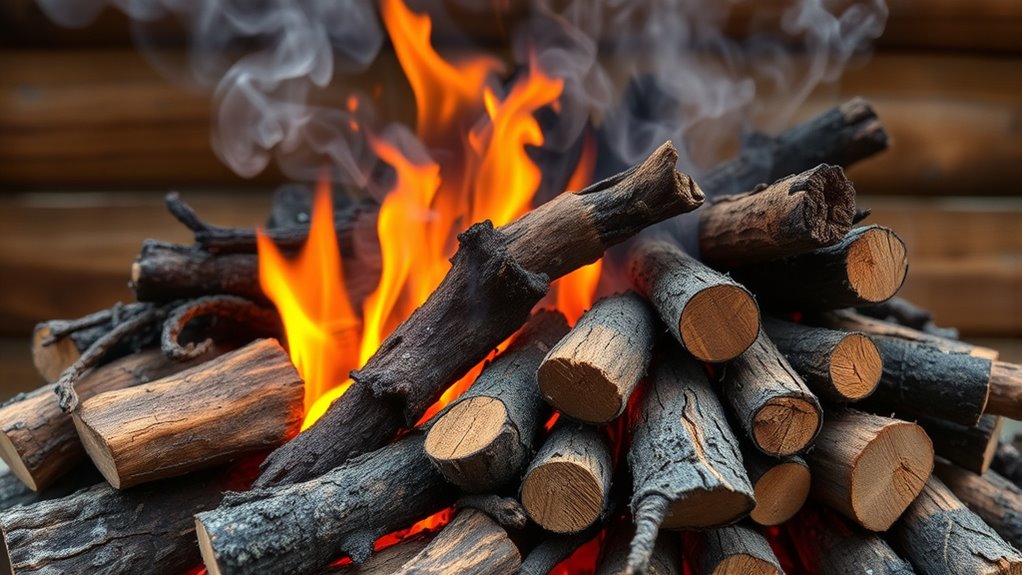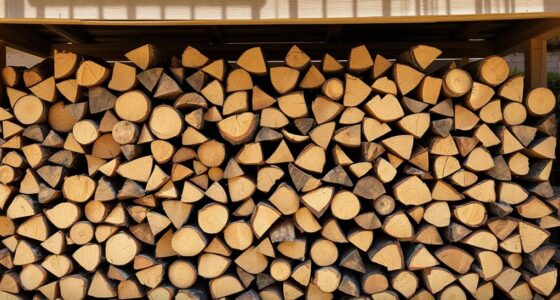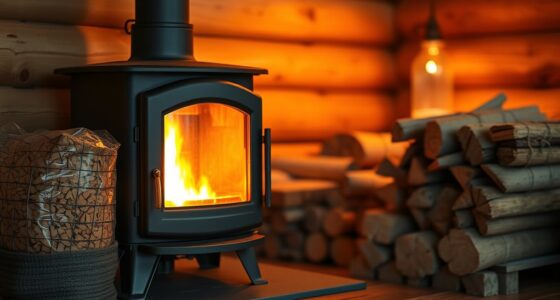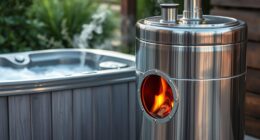Pine and spruce are poor choices for daily heating because they have high moisture content, making them burn inefficiently and produce more smoke and creosote, which can clog your chimney and cause fires. Their natural resins vaporize and leave behind deposits that require frequent cleaning. Plus, they burn quickly, so you need to add wood often, leading to more effort and less reliable warmth. If you want to learn how to avoid these issues, keep exploring this topic.
Key Takeaways
- High moisture content in pine and spruce reduces combustion efficiency and heat output.
- Their resinous nature causes resin buildup, increasing chimney fire risk.
- Unseasoned wood burns quickly, requiring frequent refueling and maintenance.
- Excess moisture and resin deposits lead to increased smoke, soot, and creosote.
- Short burn times and high wood consumption make them less cost-effective for daily heating.

When it comes to daily heating, pine and spruce wood are popular choices due to their availability and efficient burning qualities. However, these woods come with notable drawbacks that can make them less ideal for consistent, long-term use. One of the main issues is their high moisture content. Freshly cut pine and spruce contain a significant amount of water, which means you need to dry them thoroughly before burning. Burning wood with high moisture content leads to inefficient combustion, producing more smoke, creosote, and soot. This not only reduces heat output but also increases maintenance needs for your chimney and stove. If you ignore proper drying, you risk creating hazardous creosote buildup, which can ignite and cause chimney fires. Consequently, you need to invest extra effort in seasoning these woods properly, which can take months, especially in humid environments.
Another problem associated with pine and spruce is resin buildup. Both types of wood are resinous, meaning they contain natural resins that melt and vaporize when burned. While this characteristic makes them burn quickly and hot, it also results in sticky resin deposits inside your stove or chimney. Over time, this resin buildup can clog vents, restrict airflow, and reduce heating efficiency. It also increases the risk of dangerous chimney fires because resin is highly flammable. You’ll find yourself cleaning the stove and chimney more frequently to prevent these hazards, which can be time-consuming and messy. The resin tends to accumulate rapidly if the wood isn’t properly seasoned, further exacerbating the problem.
Furthermore, the rapid burning of pine and spruce means they don’t last as long as denser hardwoods. You’ll find yourself needing to constantly add more wood to keep your home warm, which can be inconvenient and less cost-effective in the long run. Their quick burn rate also produces more ash, requiring frequent cleaning to maintain ideal stove performance. And because they burn faster, they may not provide as consistent and even heat as hardwoods, leading to fluctuating indoor temperatures.
Frequently Asked Questions
Can Pine or Spruce Be Used Safely in Indoor Fireplaces?
You can use pine or spruce in indoor fireplaces, but you should do so cautiously. These woods can produce more creosote buildup, increasing fire safety risks, and emit higher levels of indoor air pollution. To protect yourself and your home, guarantee proper chimney maintenance, use seasoned wood, and avoid overusing these woods. Always prioritize safe burning practices to minimize health hazards and prevent fire hazards.
Are There Environmental Benefits to Burning Pine or Spruce?
Think of burning pine or spruce as adding a splash of green to your energy routine. While they’re renewable energy sources, their environmental benefits are limited if sourced unsustainably. If you choose sustainably harvested wood, you support sustainable forestry, reducing reliance on fossil fuels. However, they produce more emissions than hardwoods, so consider the environmental impact before burning them daily. Proper sourcing and moderation make a difference.
How Does the Scent of Pine and Spruce Affect Indoor Air Quality?
You might notice that burning pine and spruce releases essential oil emissions, which can create a pleasant scent but also introduce allergenic compounds into your indoor air. These emissions can irritate your respiratory system, especially if you have allergies or asthma. The scent may seem invigorating initially, but prolonged exposure to allergenic compounds can degrade indoor air quality, making it harder to breathe comfortably and potentially causing health issues over time.
What Are the Legal Restrictions on Burning Pine or Spruce?
Burning pine or spruce is like playing with fire, and legal restrictions are strict to keep you safe. You must follow regulations on firewood storage and make sure your firewood is properly seasoned to meet local laws. Many areas restrict burning these woods because they produce more creosote and emissions, risking legal penalties. Always check your local regulations to stay compliant and avoid fines while heating responsibly.
Do Pine and Spruce Produce More Creosote Buildup Than Other Woods?
Yes, pine and spruce tend to produce more creosote buildup than hardwoods, which can clog your chimney and pose fire hazards. Their resinous nature reduces fuel efficiency, meaning you’ll burn more wood to get the same heat. To keep your stove cleaner and more efficient, consider using hardwoods like oak or maple instead, as they burn cleaner and generate less creosote buildup over time.
Conclusion
While pine and spruce might seem like easy options for daily heating, they’re actually poor choices due to high resin content and quick burning. Imagine trying to keep a fire going with wet paper—you’ll constantly struggle to maintain heat. Instead, choose seasoned hardwoods like oak or maple for reliable, steady warmth. This way, you’ll avoid frequent refueling and smoky fires, ensuring your home stays cozy and safe without the hassle of unpredictable fires.










